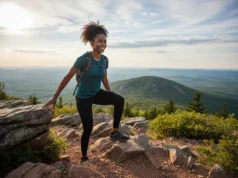In this article
Youre halfway up a stunning ridgeline when the weather turns. Your comfortable “athleisure” pants are now soaked, heavy, and clinging uncomfortably, chilling you with every gust of wind. This is the moment every hiker dreads—the moment your gear fails you. The right pair of female hiking pants isnt just about comfort; its a critical piece of equipment that directly impacts your safety, endurance, and enjoyment on the trail. This comprehensive buyers guide to the best ladies hiking pants will demystify the technology and provide a clear, data-driven framework to help you choose the perfect trekking pants for ladies for any adventure, from local trails to the expedition of a lifetime.
Before we dive in, let’s map out the journey. First, you will learn the code, understanding the non-negotiable performance metrics—durability, mobility, weather-resistance, and breathability—that separate true best womens trekking pants from everyday leggings. Next, you will identify your mission by discovering which of the three primary hiker personas you are—The Expedition Leader, The Weekend Warrior, or The Trail-to-Town Trekker—to narrow your search instantly. Finally, you will gear up with confidence, armed with our tested & reviewed recommendations for every hiking style, use-case, and budget, ensuring your next purchase of trek pants womens is an investment, not a regret.
How to Choose the Right Female Hiking Pants: An Experts Framework
This section is designed to arm you with the objective knowledge needed to make a smart, confident choice. Were going to deconstruct the key performance attributes of quality hiking bottoms womens, moving beyond marketing jargon to what actually matters when youre on multi-day adventures, miles from the trailhead.
Why Do Comfort & Mobility Matter Most?
Above all else, comfort is the foundation of endurance and safety on the trail. Pants that are too tight, that bunch up, or that restrict your movement dont just feel annoying; they actively work against you. Restrictive pants cause premature muscle fatigue and can even compromise your stability on rugged terrain where a high step or a sudden scramble is required. This addresses the core of the hiking pants vs leggings debate; while leggings offer comfort, true technical pants provide superior mobility and protection.
The key to unlocking true mobility lies in the fabric and the fit. Look for materials with four-way stretch, typically achieved by blending nylon or polyester with spandex or elastane. This allows the fabric to move with you, not against you. But fabric blend is only part of the equation. A well-designed pant incorporates specific construction features like articulated knees—pre-bent sections that mimic your natural leg shape—and a stretch gusset. That small diamond-shaped piece of fabric sewn into the inseam, what I call the “diamond of freedom,” is a game-changer for preventing blowouts and allowing for an unrestricted range of motion. Finally, pay close attention to the waistband. A good front waistband and back waistband should be flat, soft, and designed to sit comfortably under a backpack hip belt to ensure a no-chafe experience on long treks. Because unrestricted movement and proper moisture management are key to preventing discomfort, choosing trail pants womens that consider body-flattery and offer multiple inseam options is the first step toward a successful hike. This link connects our discussion of pant comfort and mobility to the foundational concept of blister prevention, which is directly impacted by fabric choice and fit.
Once you can move without restriction, the next question is whether your pants can survive the journey.
How Do I Judge Durability and Construction Quality?
A pant’s durability is its ability to resist the constant abrasion from scrambling over rocks, snagging on thorny brush during bushwhacking, and the general wear-and-tear of life outside. The core fabric blend is your first clue. While both are excellent, nylon hiking pants womens are generally more abrasion-resistant than polyester, giving them an edge for rugged, off-trail adventures.
Beyond the base material, look for construction elements that signal true quality. Many top-tier ripstop pants use a weave, identifiable by a tiny grid pattern in the fabric, that is designed to stop small tears from becoming catastrophic failures. Pay attention to the stitching in high-stress areas like the crotch and knees; reinforced stitching, sometimes called bar-tacking, is a sign that the manufacturer expects the pant to be pushed hard. Lastly, check the hardware. High-quality zippers from brands like YKK and well-designed usable pockets are far less likely to fail when youre miles from civilization, a small detail that makes a world of difference.
Pro-Tip: Pack a small gear repair patch, like Tenacious Tape, in your first-aid kit. For a few grams of weight, you can perform a field repair on a tear or snag, preventing it from getting worse and keeping wind and moisture out until you get home.
A durable pant protects you from the elements, but it must also actively shield you from the weather.
What Level of Weather Resistance Do I Actually Need?
Weather-resistance is your first line of defense against wind and light rain, which are crucial for maintaining thermal comfort. Most quality hiking pants feature a Durable Water Repellent (DWR finish). This is a chemical coating applied to the fabric that causes water to bead up and roll off rather than soaking in. It’s important to understand that DWR makes a pant water-resistant, not waterproof. For most three-season hiking, this is exactly what you want.
Wind resistance, often a feature of tightly woven softshell fabrics, is equally critical. It prevents convective heat loss, where wind strips away the warm layer of air next to your skin, making you feel much colder than the thermometer suggests. A final, often-overlooked aspect of weather resistance is the use of sun-protective fabric. An Ultraviolet Protection Factor (UPF rating) on a pant indicates how much UV radiation it blocks. A UPF 50+ rating is a critical, health-related feature for long days above the treeline or in exposed desert environments like Arizona. For more information on this, we trust the experts at The Skin Cancer Foundations guide to sun-protective clothing.
Fending off external moisture is only half the battle; managing the moisture you create from the inside is just as critical.
Why is Breathability More Important Than Waterproofing for Most Hikes?
For the vast majority of hiking situations, breathability trumps waterproofing every time. This directly answers the common question, “What are the best womens hiking pants for hot weather?” The answer is always the most breathable summer hiking pants womens. Breathability is a fabrics ability to allow water vapor—your sweat—to escape. This process, known as moisture-wicking, relies on synthetic fabrics to pull sweat away from your skin and move it to the exterior of the garment where it can evaporate.
This is the single biggest reason to avoid cotton. Non-breathable fabrics trap that sweat against your skin, leading to a clammy, chilled feeling and a dramatically increased risk of hypothermia, even in mild conditions. Excellent breathability is also directly linked to quick-dry performance. After a surprise rain shower or river crossings, breathable womens summer hiking trousers will dry out quickly from your body heat, restoring your comfort and safety. This focus on managing moisture from the inside out is a core principle of effective hiking attire for ladies. This link connects our detailed discussion of pant breathability to the broader, foundational concept of layering systems and performance fabrics for womens hiking apparel.
Pro-Tip: For pants that have zippered thigh vents, use them proactively. Open them up on a steep, strenuous ascent before you start to feel overheated. This type of mechanical venting is far more effective at dumping heat and moisture than even the most breathable fabrics alone.
Our Selection Process: How We Built This Guide
To build this guide and earn your trust, we committed to a rigorous and transparent curation process rooted in objectivity. Our recommendations are the result of a comprehensive side-by-side comparison and analysis of the female hiking pants market, driven by hard data and real-world performance, not brand loyalty.
Our process began as we synthesized dozens of technical guides and expert reviews to establish the five core performance criteria detailed above: Comfort & Mobility, Durability, Weather Resistance, Breathability, and Features. Our expert testers then compiled a master database of over 20 top-rated pants, including staples like the KUHL Freeflex Roll-Up and REI Sahara Convertible. We meticulously analyzed each products specifications, performance scores, sustainability certifications (like bluesign or Fair Trade), and aggregated thousands of user reviews to match the strongest contenders to the distinct needs of our key hiker personas.
Our field testing is where these pants prove themselves. We dont just look at spec sheets; we take these pants on real-world adventures, from the San Juan mountains of the Colorado Rockies to the challenging terrain of the Tetons. This includes subjecting them to controlled soak/dry tests during unexpected storms and rub tests on abrasive granite, providing insights that go far beyond what a label can tell you. This female-focused approach ensures our recommendations are grounded in real-world female hiker scenarios.
A quick note on affiliate links: If you choose to purchase a product through one of our links, we may earn a small commission at no extra cost to you. This helps support our independent work, but our recommendations are, and always will be, based on independent research and merit.
The Best Female Hiking Pants of 2025: Our Top Recommendations for Every Need
Now its time to match the right gear to your mission. Weve curated our top recommendations of trekking pants women, empowering you to make a final, confident decision based on your specific needs on the trail.
Our Top Picks for The Expedition Leader
This user operates in demanding environments where gear failure is not an option. She prioritizes absolute durability and weather resistance for multi-day adventures, off-trail navigation, and alpine conditions. Her layering suitability is paramount when selecting womens backpacking pants for a 4-day loop or a 70-day expedition, requiring a robust layering system with a base-layer and rain pants.
Our Top Picks for The Weekend Warrior
This is the core of the hiking market. This user needs a versatile, high-performing pant for on-trail day hikes and backpacking trips. She balances comfort, breathability, and durability, and wants practical features like those found in womens cargo hiking pants. For ladies who need womens hiking pants with pockets, this category delivers. She appreciates a product that offers excellent budget & value and three-season versatility.
Our Top Picks for The Trail-to-Town Trekker
This users lifestyle blurs the line between outdoor activity and daily life. She needs a pant that performs for light hikes but also looks and feels great for travel, errands, or après-hike brunch pants. She prioritizes comfort and aesthetic versatility, often favoring a modern fit type like a womens hiking jogger or straight fit silhouette for its trail-to-town appeal. These cute hiking pants are perfect as camping pants womens or general adventure pants womens.
Conclusion
The search for the perfect women’s hiking pants comes down to a few core truths. The best models are made from synthetic blends of nylon or polyester with spandex that prioritize mobility, moisture management, and durability over all else. Your ideal pant depends entirely on your primary activity; expedition-focused trailblazers need bombproof durability, weekend hikers need a versatile balance of breathability and comfort, and casual users value style and a soft feel. Finally, key features like a gusseted crotch, articulated knees, and a backpack-compatible waistband are the non-negotiable hallmarks of a well-designed technical pant that will prevent discomfort on long days.
Choosing the right gear is the first step to a successful adventure. Now that youre equipped with the knowledge, its time to hit the trail. Have a favorite pant we missed or a question about fit? Share your experience in the comments below!
Frequently Asked Questions about Female Hiking Pants
What is the best material for female hiking pants?
The best materials are unquestionably synthetic blends. Look for pants made primarily of nylon or polyester with a percentage of spandex (also called elastane) added for stretch. Nylon hiking pants womens offer superior durability and abrasion resistance, making them ideal for rugged terrain. Polyester is often more hydrophobic, meaning it offers quick-dry performance perfect for hot-weather hiking during the summer. You should avoid cotton at all costs. Cotton absorbs moisture, holds it against your skin, and loses all its insulating properties, creating a serious safety hazard in cool or wet conditions.
Risk Disclaimer: Hiking, trekking, backpacking, and all related outdoor activities involve inherent risks which may result in serious injury, illness, or death. The information provided on The Hiking Tribe is for educational and informational purposes only. While we strive for accuracy, information on trails, gear, techniques, and safety is not a substitute for your own best judgment and thorough preparation. Trail conditions, weather, and other environmental factors change rapidly and may differ from what is described on this site. Always check with official sources like park services for the most current alerts and conditions. Never undertake a hike beyond your abilities and always be prepared for the unexpected. By using this website, you agree that you are solely responsible for your own safety. Any reliance you place on our content is strictly at your own risk, and you assume all liability for your actions and decisions in the outdoors. The Hiking Tribe and its authors will not be held liable for any injury, damage, or loss sustained in connection with the use of the information herein.
Affiliate Disclosure: We are a participant in the Amazon Services LLC Associates Program, an affiliate advertising program designed to provide a means for us to earn advertising fees by advertising and linking to Amazon.com. As an Amazon Associate, we earn from qualifying purchases. We also participate in other affiliate programs and may receive a commission on products purchased through our links, at no extra cost to you. Additional terms are found in the terms of service.





